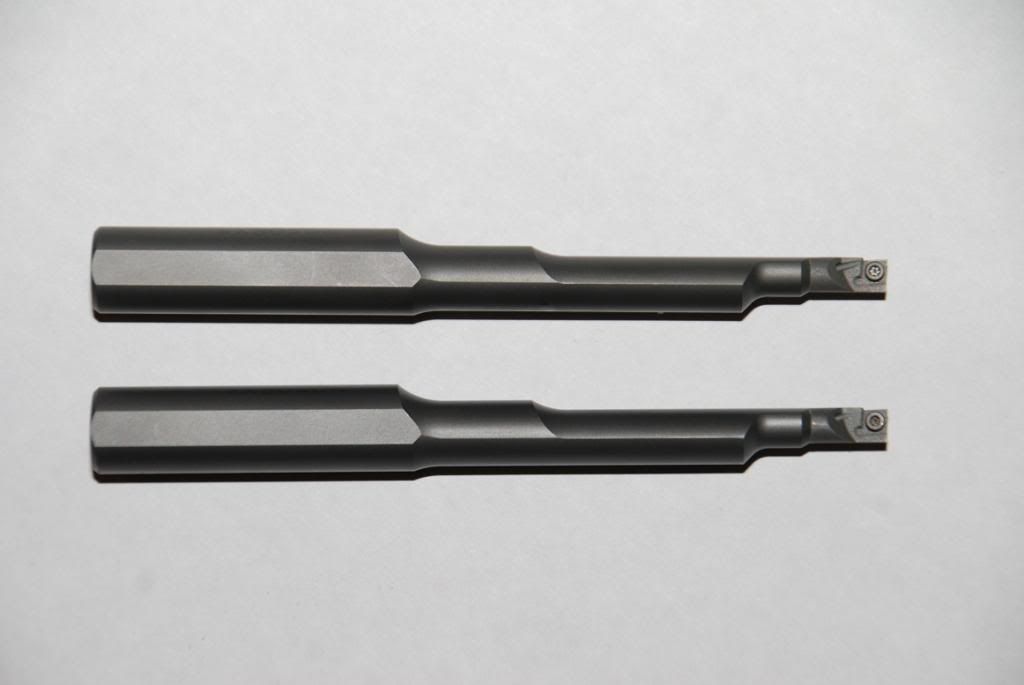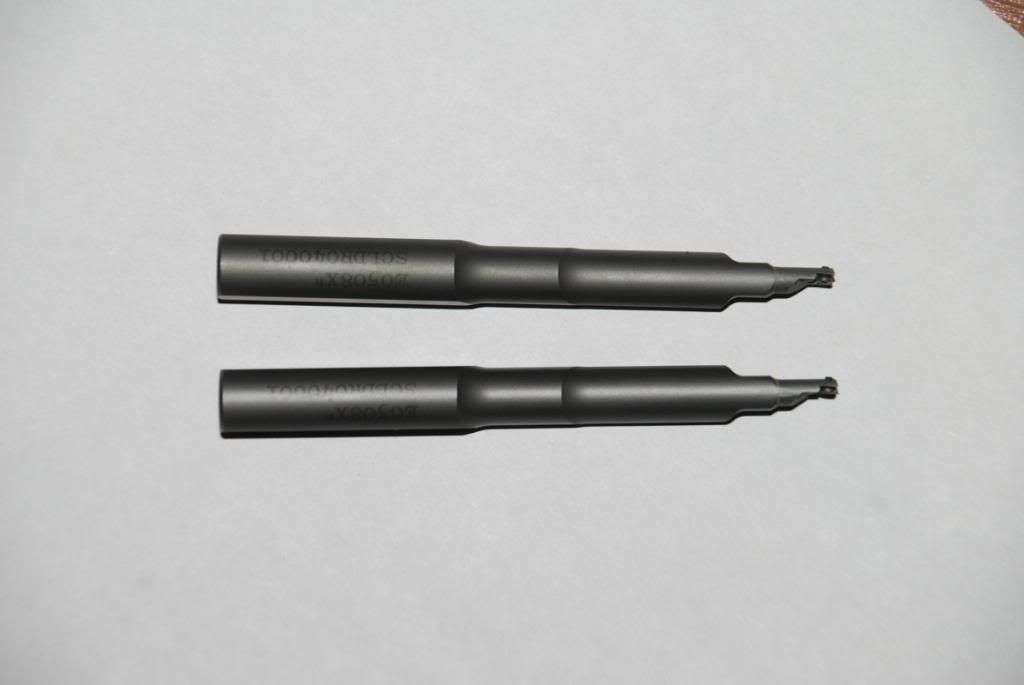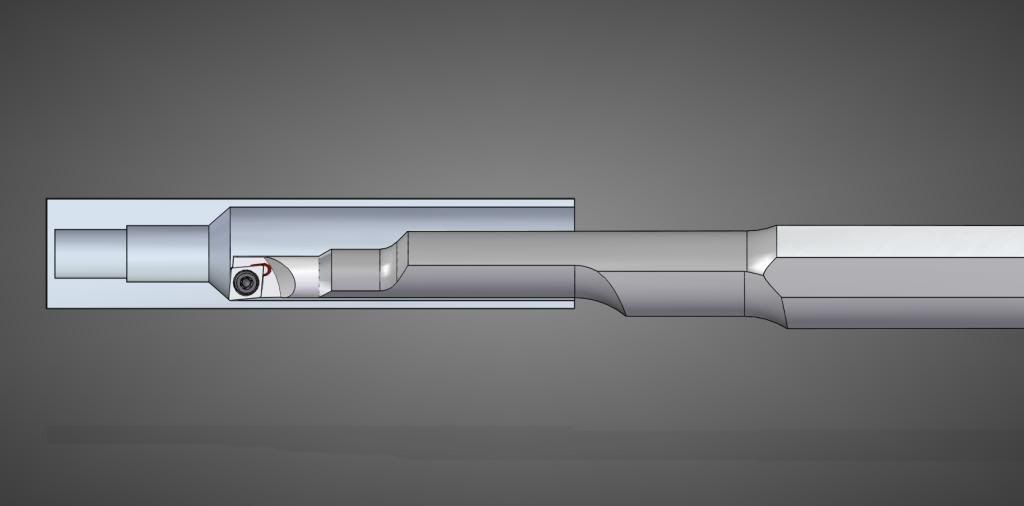Join the Hide community
Get access to live stream, lessons, the post exchange, and chat with other snipers.
Register
Download Gravity Ballistics
Get help to accurately calculate and scope your sniper rifle using real shooting data.

Install the app
How to install the app on iOS
Follow along with the video below to see how to install our site as a web app on your home screen.
Note: This feature may not be available in some browsers.
You are using an out of date browser. It may not display this or other websites correctly.
You should upgrade or use an alternative browser.
You should upgrade or use an alternative browser.
Gunsmithing A sweet little, expensive package from Switzerland arrived today............
- Thread starter 308nate
- Start date
What are the advantages/disadvantages of doing a chamber or die that way compared to a more conventional reamer?
my guess is not having to buy a million reamers, but i might be wrong. Or for non-existent wildcats  i prefer my second reason.
i prefer my second reason.
It appears somebody has been snooping around in my photobucket album 
Ya you got it right!
Was in town today and when I got home I found somenbody beat me to posting my own pictures!
Ya you got it right!
Was in town today and when I got home I found somenbody beat me to posting my own pictures!
What are the advantages/disadvantages of doing a chamber or die that way compared to a more conventional reamer?
First off, I will say I am in the experimental stages, so I make no claims as to how this will work, but will definitely be sharing the results. These boring bars are designed to handle boring chambers from the 6br caliber/case diameter to the 300WSM length/caliber.
Advantages: they allow the chamber to be cut true to the bore instead of the land diameter, not really my motivation for designing these as land to groove should be held very consistent on today's precision barrels.
If you noticed these bars are through coolant. I'll be running 120# of water soluble coolant through these to eliminate the use high sulfur cutting oil. This will allow me to make easy neck diameter changes as well as throat and lead changes, case improvements, when making wildcats, making resizing dies will be a matter of just changing an X offset. This bar will go on a toolbar on my Haas TL1 which also holds a turning tool, threading tool, a carbide drill to hog most of the material out then the boring bar will be used to cut the chamber to headspace.
Very nice tooling.
Reamers have the advantage of less prone to chatter and repeatability for diameters. Boring chambers you need to watch for deflection and chatter issues thru programming and no worry of a pilot rubbing you new barrel.
I doubt you will have any problems boring chambers but the throat angle could be interesting depending on the insert used.
Reamers have the advantage of less prone to chatter and repeatability for diameters. Boring chambers you need to watch for deflection and chatter issues thru programming and no worry of a pilot rubbing you new barrel.
I doubt you will have any problems boring chambers but the throat angle could be interesting depending on the insert used.
Not sure if Kennametal makes an insert for that, but I have been having outstanding luck with their KC5010 grade on my triangular boring
bar inserts. Great balance between hardness and toughness. Excellent tool life and rarely any chipping with a .007 nose radius, especially in extended reach set ups where there is a bit of chatter involved. I cut mainly 300 series SST.
Just thought I'd throw that out there.
bar inserts. Great balance between hardness and toughness. Excellent tool life and rarely any chipping with a .007 nose radius, especially in extended reach set ups where there is a bit of chatter involved. I cut mainly 300 series SST.
Just thought I'd throw that out there.
Watching with interest. Please update this thread with your results, or post a link to the new thread.
I've often wondered why I've never seen or heard about chambers/dies being bored via single point cutter. Obviously, it only applies to CNC, but CNCs have become so prolific over the last 10 years, it seems like it would be fairly common.
I question how well that spindly little boring bar is going to deal with the interrupted cut while cutting the lead-in to the lands, especially the last few .001s where it's cutting so little. A set of throating reamers may be needed to augment your cutters.
Certainly some experimentation will be in order to solve the tool deflection/compliance issues.
Keep us apprised!
I've often wondered why I've never seen or heard about chambers/dies being bored via single point cutter. Obviously, it only applies to CNC, but CNCs have become so prolific over the last 10 years, it seems like it would be fairly common.
I question how well that spindly little boring bar is going to deal with the interrupted cut while cutting the lead-in to the lands, especially the last few .001s where it's cutting so little. A set of throating reamers may be needed to augment your cutters.
Certainly some experimentation will be in order to solve the tool deflection/compliance issues.
Keep us apprised!
It would be pretty easy to cut the throat with throating reamers but either way would work if the tool has enough clearance to cut it. It will be interesting to see the outcome.
Got hooked in when you said Switzerland---my uncle is Swiss, and brags (rightfully so) about their precision machinery etc. Hope to see pics/threads about your progress with these nifty little toys---I mean tools.
Got hooked in when you said Switzerland---my uncle is Swiss, and brags (rightfully so) about their precision machinery etc.
Years ago, when the only watches available were wind ups, the American Watchmakers Institute developed a tiny spring steel wire for watch main springs. They were so proud of this wire that they sent a piece of it to their Swiss counterparts. The Swiss were unsure what to do with it so they drilled a hole in it and sent it back.
Yes, that was a joke.
It is certainly doable and it has been done but IMO the quality of the complete chamber including the throat will be difficult to match that of a good reamer.
Programing should be no problem. (15-20min. job) Yes, interrupted cutting when boring the lead may cause problems this is why we used the absolute ridged geometry in the design. If that is the case the throating reamer will need to be used. The insert is a CDGT with DX30 or DX50. Here is a pic of the inserts. They arrived today.
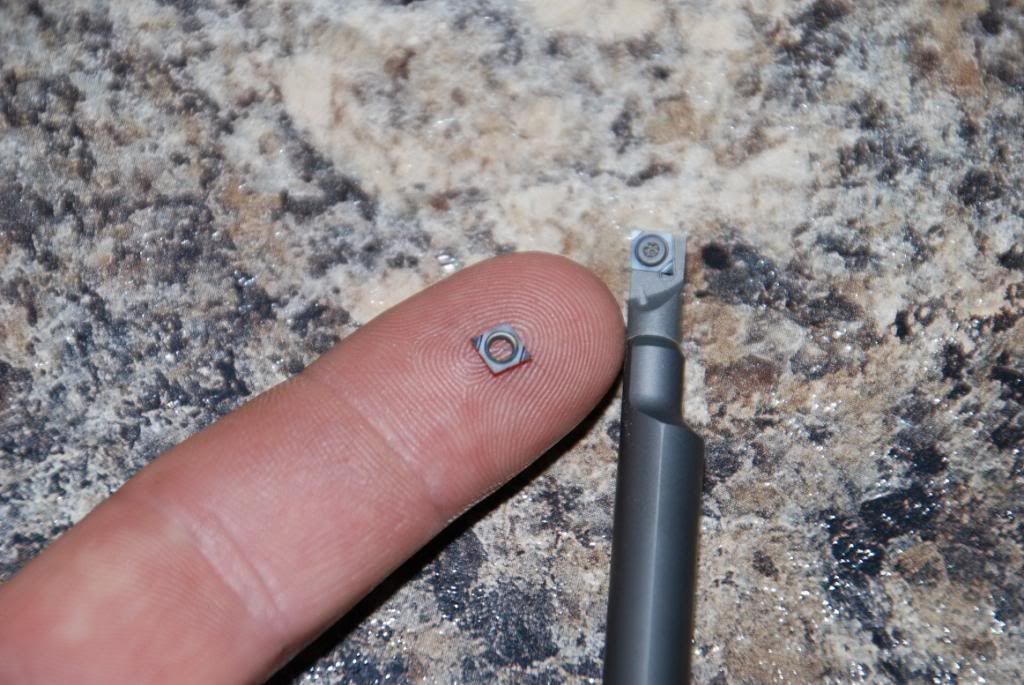
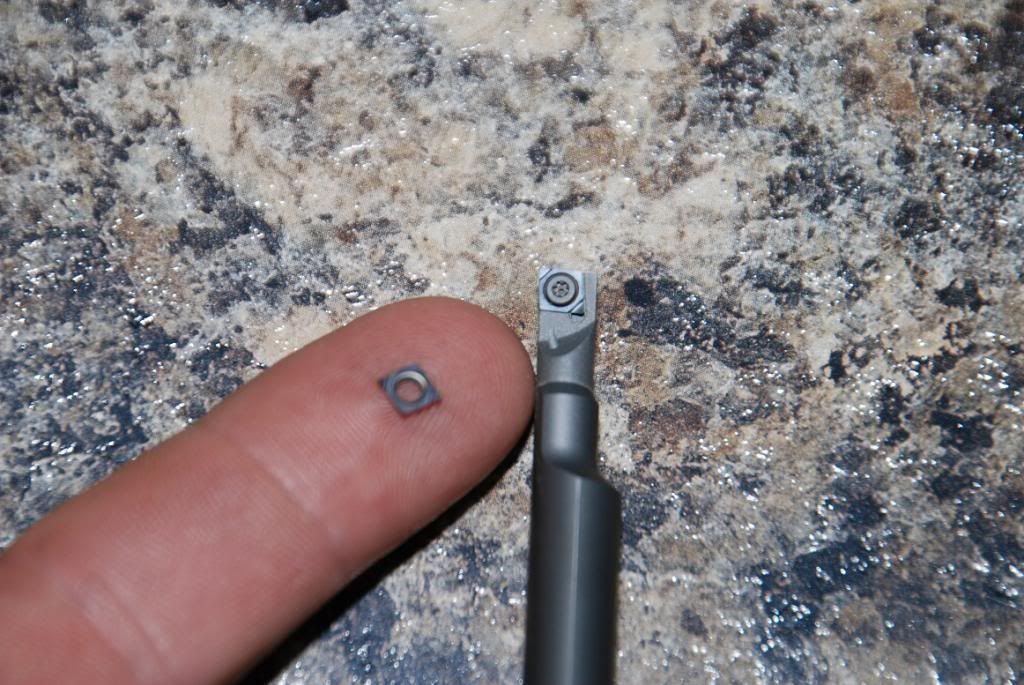


I really like this idea. Nice job designing the bars. I think you'll make this work. Do you have an indicator with a stylus that is long enough to measure runout at the throat? Obviously a bored chamber will be true to the spindle axis and insensitive to the actual location of the bore which might make establishing concentricity a challenge unless the bore has been brought to the spindle axis. However, this problem is easily solved.
I really like this idea. Nice job designing the bars. I think you'll make this work. Do you have an indicator with a stylus that is long enough to measure runout at the throat? Obviously a bored chamber will be true to the spindle axis and insensitive to the actual location of the bore which might make establishing concentricity a challenge unless the bore has been brought to the spindle axis. However, this problem is easily solved.
If you take a look at Nate's website I think you'll find he has this covered pretty well. Straight Shot Gunsmithing
I really like this idea. Nice job designing the bars. I think you'll make this work. Do you have an indicator with a stylus that is long enough to measure runout at the throat? Obviously a bored chamber will be true to the spindle axis and insensitive to the actual location of the bore which might make establishing concentricity a challenge unless the bore has been brought to the spindle axis. However, this problem is easily solved.
Thanks.
Yes, I am using and Interapid( also swiss made.) test indicator with a 2.75 contact point length .0005 graduation.
calibrated for the 2.75 length.
.338 norma case in picture

for bore alignment I am using my True Bore Alignment System. and my SSG range rods for roughing in the bore and then I finish with the Interapid testing tool.
It is quite efficient and easy to get bores running +/- .0001. Yesdefinitelyfinitly excited to get going on this. I have a few more urgent rifles to finish up then i should have a little more time to "play" with it.
Insert style Denitool .0079 radius
True Bore Alignment System
Nate.
Last edited:
Thats not gonna work , you should send that foreign garbage to me so i can help you prevent any undo stress.. I'm sure i could put it to use here for the new Orinion capsule.
Glad to see that you are doing well , i hope you and the family are good , I need to call and shoot the breeze with you again soon
Cheers , James
Glad to see that you are doing well , i hope you and the family are good , I need to call and shoot the breeze with you again soon
Cheers , James
Having spent my entire adult life playing with CNC's in some form or another I'm surprised single point cut chambers aren't more common. Those boring bars look great for the task at hand.
IMHO the key to getting it to work will be getting comfortable with having the RPM where the insert will like it. I'd expect a CSS upwards of 200 with max RPM set to around 3300 if the TL 1 will do it
I'd try a feedrate of .003-.004 IPR.
HTH,
LM
IMHO the key to getting it to work will be getting comfortable with having the RPM where the insert will like it. I'd expect a CSS upwards of 200 with max RPM set to around 3300 if the TL 1 will do it
I'd try a feedrate of .003-.004 IPR.
HTH,
LM
Either it is working so good that he is being quiet about it or there is some surface finish issues once in the interrupted cut of the lead taper.
This is by far the best designed boring bar for this particular use. Even with a very rigid setup, interrupted cut surface finish can be less than precise. I imagine with the length of the boring bar, this may be amplified.
I missed the thread a year ago but I am really looking forward to an update. Props for designing and trying this what ever the result ended up being.
This is by far the best designed boring bar for this particular use. Even with a very rigid setup, interrupted cut surface finish can be less than precise. I imagine with the length of the boring bar, this may be amplified.
I missed the thread a year ago but I am really looking forward to an update. Props for designing and trying this what ever the result ended up being.
Last edited:
I've bored chambers before on the CNC. I used round carbide blanks split to c/l and the hand ground and checked on an optical comparator. I had my best luck drilling first, then using a G71 cycle where I could vary my depth of cut, feed and finish allowance on the roughing tool and then just use a G70 with the finish tool. On stubby cases like 6 BR it's pretty simple, but on a longer cartridge you have to be aware of the bore to length ratio for your carbide bar. 6 x the bar diameter isn't bad, but something like a .257 Roberts gets deep by the time you clear the throat taper on the small end. Speed will be an issue though. I don't see turning a 28" long 4lb barrel at high rpm to make the cutters happy. With constant surface speed(G96 S200) at the start of a chamber at .5 diameter it will be running around 1500rpm, when it starts down the shoulder and moves that short distance from body to neck at say .25 diameter it will speed up to around 3000rpm then proceed in Z axis. I think something that heavy is going to get harmonic issues and either chatter, or cut an out of round neck and throat. In all honesty, I think a reamer is going to be hard to beat.
Last edited:
Similar threads
- Replies
- 39
- Views
- 1K
